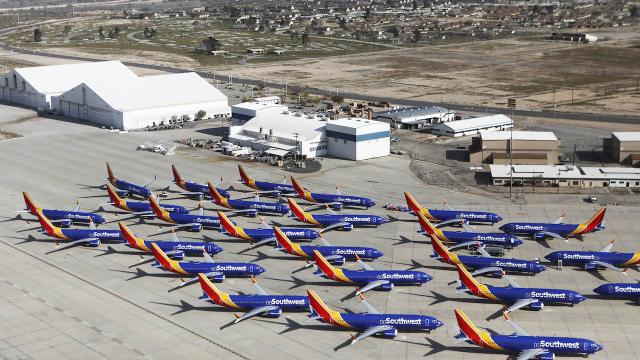Boeing and the Federal Aviation Administration (FAA) have suggested that the pilots of two flights in Ethiopia and Indonesia didn’t follow proper procedures before their 737 Max 8 planes crashed in recent months.
However, new reports indicates that the pilots in Ethiopia tried to do the right thing and override the plane’s automation but crashed anyway.
The reports come from Reuters and the Wall Street Journal and tell similar stories about what happened on the March 10 flight in Ethiopia that killed 157 people.
According to Reuters, the pilots of Ethiopian Airlines Flight 302 did what they were supposed to do in order to take control of the plane, but the software may have re-engaged “as many as four times.”
From the day that the Ethiopian Airlines plane crashed, experts have been concerned that the disaster could have been caused by an automation system designed to keep the 737 Max planes from stalling. The Manoeuvring Characteristics Augmentation System (MCAS) helps to push the nose of the plane down when it detects that the aircraft might stall.
But in the case of a faulty reading, pilots need to override the automation. These new reports suggests that the pilots may have done that, at least initially.
According to Reuters, it’s still unclear why the software re-engaged, but investigators are, “studying the possibility that the software had kicked in again without human intervention.” And this is where the Reuters and WSJ reports differ, because the Wall Street Journal cites “people briefed on the probe’s preliminary findings” to suggest the pilots themselves may have re-engaged the automation.
From the Wall Street Journal:
The pilots on Ethiopian Airlines Flight 302 initially reacted to the emergency by shutting off power to electric motors driven by the automated system, these people said, but then appear to have re-engaged the system to cope with a persistent steep nose-down angle. It wasn’t immediately clear why the pilots turned the automated system back on instead of continuing to follow Boeing’s standard emergency checklist, but government and industry officials said the likely reason would have been because manual controls to raise the nose didn’t achieve the desired results.
After first cranking a manual wheel in the cockpit that controls the same movable surfaces on the plane’s tail that MCAS had affected, the pilots turned electric power back on, one of these people said. They began to use electric switches to try to raise the plane’s nose, according to these people. But the electric power also reactivated MCAS, allowing it to continue its strong downward commands, the people said.
All of the new information has been taken from the doomed flight’s black box recorder which was recovered intact. Boeing did not immediately respond to Gizmodo’s request for comment.
Boeing has received criticism in recent weeks over revelations that key safety features on the new Boeing Max planes were sold as “extras”. For example, a light that would notify pilots when sensors may be giving a false reading to the anti-stall software, was not included as a standard feature on the Boeing Max-8.
The investigation into what caused the crash of Ethiopian Flight 302 is still ongoing, though all Boeing Max planes have been grounded around the world. It was the second crash of a Boeing Max-8 plane in five months following the crash of Lion Air flight 610 off the coast of Indonesia on October 29, 2018 that killed all 189 on board.
Boeing has promised a software update for its Max planes “by April,” but that deadline may be getting an extension. The FAA says that it needs time to properly evaluate the software before it’s installed.
“The FAA expects to receive Boeing’s final package of its software enhancement over the coming weeks for FAA approval,” an FAA spokesperson said in a statement to Ars Technica.
“Time is needed for additional work by Boeing as the result of an ongoing review of the 737 MAX Flight Control System to ensure that Boeing has identified and appropriately addressed all pertinent issues.”
A report with preliminary findings about what actually happened to Ethiopian Flight 302 is expected in the coming days.
[Reuters and Wall Street Journal]
